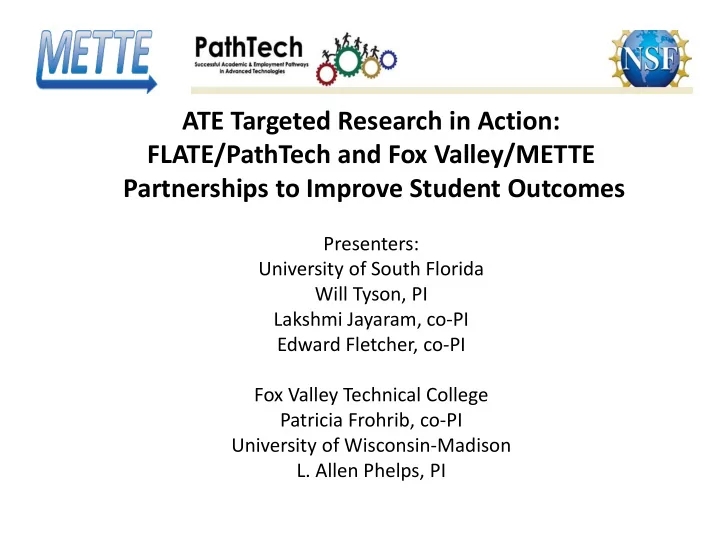

ATE Targeted Research in Action: FLATE/PathTech and Fox Valley/METTE Partnerships to Improve Student Outcomes Presenters: University of South Florida Will Tyson, PI Lakshmi Jayaram, co-PI Edward Fletcher, co-PI Fox Valley Technical College Patricia Frohrib, co-PI University of Wisconsin-Madison L. Allen Phelps, PI
Introductions: PathTech Team and METTE Team Workshop Overview The ATE Targeted Research Priority Why Targeted Research on Technician Education Matters The National College Completion Agenda State Level Performance Funding (WI and FL) Local college initiatives (FVTC) Strategic Planning Program Improvement and Performance Scorecards To focus our remarks: What information, if available, would be most useful for improving ATE student success or outcomes?
Mixed Methods Research Design • Quantitative • Education and employment administrative data • Institutional, state, and national public and private data sources • Study transition from high school and the workforce into advanced technologies • Study short-term and long-term post-schooling outcomes • Qualitative • Interviews and focus groups • College students, faculty, and administrators • High school students and personnel • Employers and key stakeholders
Successful Academic and Employment Path ways in Advanced Tech nologies • ATE Center/University Partnership • FLATE Regional Center of Excellence/University of South Florida (Tampa, FL) • Pathways Research • PathTech Collaborative Research Model
Hillsborough Community College (Tampa) • Advanced Manufacturing St. Petersburg College (Clearwater) • Biomedical Systems, Quality, Digital Design & Modeling Polk State College (Lakeland) • Advanced Manufacturing State College of Florida (Venice) • Electronics, Digital Design & Modeling
FLATE Engineering Technology College Network
• FLATE connects USF researchers to Tampa Bay area ET community • ET students • ET graduates • High school career academies • Industry partners
Improving Educational Outcomes in M anufacturing E ngineering T echnologist and T echnician E ducation • Research and Innovation Partnership to Improve Student Success • Five Partners: UW-Madison, FVTC, MATC- Milwaukee, MPTC, and WCTC • Student Success Model • Research and Innovation Framework
Two Guiding Questions: 1. What are the specific METTE program features that are associated with optimal student outcomes? 2. How can key METTE stakeholders use research data and findings to inform strategic program improvement decisions?
METTE Student Success Model
Research and Innovation Framework Networked Improvement Local Leadership Team Communities V-P for Instruction Local Leadership Team MFG &ENGR Dean Associate Deans Institutional Research Faculty Leaders Office Inst. Research Analysts UW Mad Researcher
METTE at FVTC Improving Student Success Through High School Partnerships 2013-16 Strategic Priority : Increase by 10% each year the number of high school graduates who enter FVTC programs with prior FVTC credits (2012 Baseline: 13.4%) Research Questions 1. In what ways do school-level and student-level characteristics influence students’ early success at FVTC? 2. Do school-level measures have an effect above and beyond their corresponding student-level measures?
PROJECT OUTCOMES 1. Provide each high school community with a report describing their graduates’ success at FVTC and beyond. 2. Create a baseline for documenting and tracking the effects of various FVTC Early Career Success partnership projects: Career Jump Start — Machine Tool (3 new dual credit courses in 5 high schools during 2013-14) Dual Credit Summer Teaching Academy (2013--5 CTE inst.) Completion of ACCPLACER by all students in Grade 11 New academy development -- manufacturing, technical or engineering 3. Benchmark the effectiveness of high school partnership linking practices
Some Early Findings Aspirations and Enrollment in STEM Fields From a national sample of 2002 high school graduates, we found: • Students who described themselves as being in both the academic & occupational tracks in high school were more likely to enroll in manufacturing programs instead of other STEM fields. • Having at least one advanced placement (AP) math credit in high school was associated with 70.3% (girls) or 25.8% (boys) more likely to aspire to manufacturing fields, and 44.2% (girls) and 7.6% (boys) more likely to actually enroll in manufacturing fields at two-year colleges. Source: Students in Manufacturing and Other STEM Fields at Two-Year Colleges: An Exploration of Aspirations and Enrollment (Spring 2012)
Some Early Findings For recent high school grads who attended one of the technical colleges in Wisconsin in 09-10 academic year, we found that: • Summer enrollment in 2009 is the strongest predictor of future educational success: Students who took summer courses were 19% more likely to be retained at the 4th term or to graduate earlier than their counterparts. • Students who experienced delayed entry to college were 6% less likely to be retained or graduate at the 4th term. Source: The Influence of Dual Enrollment and Early Academic Momentum on Two- Year Technical College Student Success (AERA, April, 2013)
Discussion Questions: How can longitudinal data be used to evaluate ATE projects, program improvements, program innovations, and to track student progress? In what ways can qualitative research methods (e.g., interviews and focus groups with students, instructors, and industry partners) clarify the importance of engineering technology (ET) programs, understand the factors affecting ET students’ decisions, and enhance our understanding of the challenges and transitions encountered in different settings by increasingly diverse students? When integrated, how can mixed methods of targeted research improve student outcomes and success in ATE pathways?
WEB-BASED RESOURCES FOR ATE PROJECTS PathTECH http://sociology.usf.edu/pathtech/team/ METTE http://mette.wceruw.org/ Evidence-Based Innovations CCSSE http://www.ccsse.org/center/ Policydirect.org http://www.policydirect.org/ OCCRL http://occrl.illinois.edu/ NRCCTE http://www.nrccte.org/ Teaching Technicians – Proven and Promising Practices https://www.teachingtechnicians.org/Resources/PPP/ CCRC http://ccrc.tc.columbia.edu/ CAPSEE http://capseecenter.org/
Recommend
More recommend